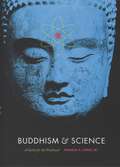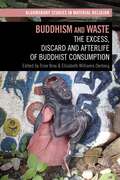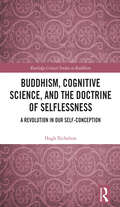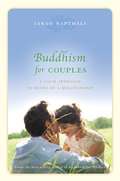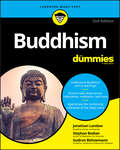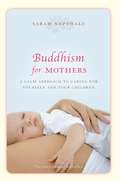- Table View
- List View
Buddhism and Postmodern Imaginings in Thailand: The Religiosity of Urban Space
by James TaylorThis book presents a rethink on the significance of Thai Buddhism in an increasingly complex and changing post-modern urban context, especially following the financial crisis of 1997. Defining the cultural nature of Thai ’urbanity’; the implications for local/global flows, interactions and emergent social formations, James Taylor opens up new possibilities in understanding the specificities of everyday urban life as this relates to perceptions, conceptions and lived experiences of religiosity. Changes in the centre are also reverberating in the remaining forests and the monastic tradition of forest-dwelling which has sourced most of the nation’s modern saints. The text is based on ethnography taking into account the rich variety of everyday practices in a mélange of the religious. In Thailand, Buddhism is so intimately interconnected with national identity and social, economic and ethno-political concerns as to be inseparable. Taylor argues here that in recent years there has been a marked reformulation of important conventional cosmologies through new and challenging Buddhist ideas and practices. These influences and changes are as much located outside as inside the Buddhist temples/monasteries.
Buddhism and Postmodern Imaginings in Thailand: The Religiosity of Urban Space
by James TaylorThis book presents a rethink on the significance of Thai Buddhism in an increasingly complex and changing post-modern urban context, especially following the financial crisis of 1997. Defining the cultural nature of Thai ’urbanity’; the implications for local/global flows, interactions and emergent social formations, James Taylor opens up new possibilities in understanding the specificities of everyday urban life as this relates to perceptions, conceptions and lived experiences of religiosity. Changes in the centre are also reverberating in the remaining forests and the monastic tradition of forest-dwelling which has sourced most of the nation’s modern saints. The text is based on ethnography taking into account the rich variety of everyday practices in a mélange of the religious. In Thailand, Buddhism is so intimately interconnected with national identity and social, economic and ethno-political concerns as to be inseparable. Taylor argues here that in recent years there has been a marked reformulation of important conventional cosmologies through new and challenging Buddhist ideas and practices. These influences and changes are as much located outside as inside the Buddhist temples/monasteries.
Buddhism and Science: A Guide for the Perplexed (Buddhism and Modernity)
by Donald S. Lopez Jr.Beginning in the nineteenth century and continuing to the present day, both Buddhists and admirers of Buddhism have proclaimed the compatibility of Buddhism and science. Their assertions have ranged from modest claims about the efficacy of meditation for mental health to grander declarations that the Buddha himself anticipated the theories of relativity, quantum physics and the big bang more than two millennia ago. In Buddhism and Science, Donald S. Lopez Jr. is less interested in evaluating the accuracy of such claims than in exploring how and why these two seemingly disparate modes of understanding the inner and outer universe have been so persistently linked. Lopez opens with an account of the rise and fall of Mount Meru, the great peak that stands at the center of the flat earth of Buddhist cosmography—and which was interpreted anew once it proved incompatible with modern geography. From there, he analyzes the way in which Buddhist concepts of spiritual nobility were enlisted to support the notorious science of race in the nineteenth century. Bringing the story to the present, Lopez explores the Dalai Lama’s interest in scientific discoveries, as well as the implications of research on meditation for neuroscience. Lopez argues that by presenting an ancient Asian tradition as compatible with—and even anticipating—scientific discoveries, European enthusiasts and Asian elites have sidestepped the debates on the relevance of religion in the modern world that began in the nineteenth century and still flare today. As new discoveries continue to reshape our understanding of mind and matter, Buddhism and Science will be indispensable reading for those fascinated by religion, science, and their often vexed relation.
Buddhism and Science: A Guide for the Perplexed (Buddhism and Modernity)
by Donald S. Lopez Jr.Beginning in the nineteenth century and continuing to the present day, both Buddhists and admirers of Buddhism have proclaimed the compatibility of Buddhism and science. Their assertions have ranged from modest claims about the efficacy of meditation for mental health to grander declarations that the Buddha himself anticipated the theories of relativity, quantum physics and the big bang more than two millennia ago. In Buddhism and Science, Donald S. Lopez Jr. is less interested in evaluating the accuracy of such claims than in exploring how and why these two seemingly disparate modes of understanding the inner and outer universe have been so persistently linked. Lopez opens with an account of the rise and fall of Mount Meru, the great peak that stands at the center of the flat earth of Buddhist cosmography—and which was interpreted anew once it proved incompatible with modern geography. From there, he analyzes the way in which Buddhist concepts of spiritual nobility were enlisted to support the notorious science of race in the nineteenth century. Bringing the story to the present, Lopez explores the Dalai Lama’s interest in scientific discoveries, as well as the implications of research on meditation for neuroscience. Lopez argues that by presenting an ancient Asian tradition as compatible with—and even anticipating—scientific discoveries, European enthusiasts and Asian elites have sidestepped the debates on the relevance of religion in the modern world that began in the nineteenth century and still flare today. As new discoveries continue to reshape our understanding of mind and matter, Buddhism and Science will be indispensable reading for those fascinated by religion, science, and their often vexed relation.
Buddhism and Science: A Guide for the Perplexed (Buddhism and Modernity)
by Donald S. Lopez Jr.Beginning in the nineteenth century and continuing to the present day, both Buddhists and admirers of Buddhism have proclaimed the compatibility of Buddhism and science. Their assertions have ranged from modest claims about the efficacy of meditation for mental health to grander declarations that the Buddha himself anticipated the theories of relativity, quantum physics and the big bang more than two millennia ago. In Buddhism and Science, Donald S. Lopez Jr. is less interested in evaluating the accuracy of such claims than in exploring how and why these two seemingly disparate modes of understanding the inner and outer universe have been so persistently linked. Lopez opens with an account of the rise and fall of Mount Meru, the great peak that stands at the center of the flat earth of Buddhist cosmography—and which was interpreted anew once it proved incompatible with modern geography. From there, he analyzes the way in which Buddhist concepts of spiritual nobility were enlisted to support the notorious science of race in the nineteenth century. Bringing the story to the present, Lopez explores the Dalai Lama’s interest in scientific discoveries, as well as the implications of research on meditation for neuroscience. Lopez argues that by presenting an ancient Asian tradition as compatible with—and even anticipating—scientific discoveries, European enthusiasts and Asian elites have sidestepped the debates on the relevance of religion in the modern world that began in the nineteenth century and still flare today. As new discoveries continue to reshape our understanding of mind and matter, Buddhism and Science will be indispensable reading for those fascinated by religion, science, and their often vexed relation.
Buddhism and the Coronavirus: The Buddha's Teaching on Suffering (The Sussex Library of Religious Beliefs & Practice)
by Jeaneane FowlerThis book examines the early teachings of Buddhism associated with the life of the Buddha, Siddhatta Gotama. In these teachings, the Buddha put forward his famous Four Noble Truths concerning the nature of suffering, its causes, the Truth that it can be overcome, and a pathway to end suffering. The suffering experienced in the contemporary coronavirus pandemic may seem to be very distant from the Buddhas message delivered over two thousand years ago, but the teaching of the Four Noble Truths is as relevant today as it was all that time ago. So this book melds the two, occasionally with discrete treatment of past and present but ever cognizant of the ways in which the teachings of the past inform the present crisis. To understand coronaviruses, the book examines the nature of viruses, their origins, causes and the ways in which they are both friends and enemies of humankind. Importantly and crucially, the book investigates how far humanity itself is the cause of its own suffering in the pandemics that arise no less in the coronaviruses that have emerged in the twenty-first century. Chapters include: The Buddha; Viruses: Friends and Enemies; The Noble Truth of Suffering; The Second Noble Truth of the Cause of Suffering; The Third Noble Truth of the Cessation of Suffering; The Fourth Noble Truth: The Noble Eightfold Path; The Noble Eightfold Path: Mindfulness and Concentration; The Brahma-vihara: Love: Compassion: Sympathetic Joy: Equanimity.
Buddhism and the Coronavirus: The Buddha's Teaching on Suffering (The Sussex Library of Religious Beliefs & Practice)
by Jeaneane FowlerThis book examines the early teachings of Buddhism associated with the life of the Buddha, Siddhatta Gotama. In these teachings, the Buddha put forward his famous Four Noble Truths concerning the nature of suffering, its causes, the Truth that it can be overcome, and a pathway to end suffering. The suffering experienced in the contemporary coronavirus pandemic may seem to be very distant from the Buddhas message delivered over two thousand years ago, but the teaching of the Four Noble Truths is as relevant today as it was all that time ago. So this book melds the two, occasionally with discrete treatment of past and present but ever cognizant of the ways in which the teachings of the past inform the present crisis. To understand coronaviruses, the book examines the nature of viruses, their origins, causes and the ways in which they are both friends and enemies of humankind. Importantly and crucially, the book investigates how far humanity itself is the cause of its own suffering in the pandemics that arise no less in the coronaviruses that have emerged in the twenty-first century. Chapters include: The Buddha; Viruses: Friends and Enemies; The Noble Truth of Suffering; The Second Noble Truth of the Cause of Suffering; The Third Noble Truth of the Cessation of Suffering; The Fourth Noble Truth: The Noble Eightfold Path; The Noble Eightfold Path: Mindfulness and Concentration; The Brahma-vihara: Love: Compassion: Sympathetic Joy: Equanimity.
Buddhism and the Political Process
by Hiroko KawanamiThis study examines the impact of Buddhism on the political process of Asian countries in recent times. The intersection between Buddhism and politics; religious authority and political power is explored through the engagement of Buddhist monks and lay activists in the process of nation-building, development, and implementation of democracy.
Buddhism and Waste: The Excess, Discard, and Afterlife of Buddhist Consumption (Bloomsbury Studies in Material Religion)
by Trine Brox Elizabeth Williams-OerbergIn what ways do Buddhists recognize, define, and sort waste from non-waste? What happens to Buddhist-related waste? How do new practices of Buddhist consumption result in new forms of waste and consequently new ways of dealing with waste? This book explores these questions in a close examination of a religion that is often portrayed as anti-materialist and non-economic. It provides insight into the complexity of Buddhist consumption, conceptions of waste, and waste care. Examples include scripture that has been torn and cannot be read, or an amulet that has disintegrated, as well as garbage left behind on a pilgrimage, or the offerings of food and prayer scarves that create ecological contamination. Chapters cover mass-production and over-consumption, the wastefulness of consumerism, the by-products of Buddhist practices like rituals and festivals, and the impact of increased Buddhist consumption on religious practices and social relations. The book also looks at waste in terms of what is discarded, exploring issues of when and why particular objects and practices are sorted and handled as sacred and disposable. Contributors address how sacred materiality is destined to wear and decay, as well as ideas about redistribution, regeneration or recycling, and the idea of waste as afterlife.
Buddhism and Waste: The Excess, Discard, and Afterlife of Buddhist Consumption (Bloomsbury Studies in Material Religion)
by Trine Brox and Elizabeth Williams-OerbergIn what ways do Buddhists recognize, define, and sort waste from non-waste? What happens to Buddhist-related waste? How do new practices of Buddhist consumption result in new forms of waste and consequently new ways of dealing with waste? This book explores these questions in a close examination of a religion that is often portrayed as anti-materialist and non-economic. It provides insight into the complexity of Buddhist consumption, conceptions of waste, and waste care. Examples include scripture that has been torn and cannot be read, or an amulet that has disintegrated, as well as garbage left behind on a pilgrimage, or the offerings of food and prayer scarves that create ecological contamination. Chapters cover mass-production and over-consumption, the wastefulness of consumerism, the by-products of Buddhist practices like rituals and festivals, and the impact of increased Buddhist consumption on religious practices and social relations. The book also looks at waste in terms of what is discarded, exploring issues of when and why particular objects and practices are sorted and handled as sacred and disposable. Contributors address how sacred materiality is destined to wear and decay, as well as ideas about redistribution, regeneration or recycling, and the idea of waste as afterlife.
Buddhism as Philosophy: An Introduction
by Mark SideritsThere has been a recent upsurge in interest in Buddhist philosophy, but there is as yet no satisfactory text on the subject. Buddhism as Philosophy fills that void. Unlike other texts that serve to introduce Buddhist thought, it is written by a philosopher and it shows how the Buddhist tradition deals with the same sorts of problems that get treated in Western philosophy and employs the same sorts of methods. This book does more than just report what Buddhist philosophers said; it presents the arguments of the Buddhist philosophers, in their own words, and it invites the reader to assess their overall cogency. In short, Buddhism as Philosophy investigates the Buddhist tradition by way of the characteristically philosophical concern for finding out the truth about complicated matters in metaphysics, epistemology and ethics.
Buddhism as Philosophy: An Introduction
by Mark SideritsThere has been a recent upsurge in interest in Buddhist philosophy, but there is as yet no satisfactory text on the subject. Buddhism as Philosophy fills that void. Unlike other texts that serve to introduce Buddhist thought, it is written by a philosopher and it shows how the Buddhist tradition deals with the same sorts of problems that get treated in Western philosophy and employs the same sorts of methods. This book does more than just report what Buddhist philosophers said; it presents the arguments of the Buddhist philosophers, in their own words, and it invites the reader to assess their overall cogency. In short, Buddhism as Philosophy investigates the Buddhist tradition by way of the characteristically philosophical concern for finding out the truth about complicated matters in metaphysics, epistemology and ethics.
Buddhism Between Religion and Philosophy: N?g?rjuna and the Ethics of Emptiness
by Rafal K. StepienN?g?rjuna (c. 150-250), founder of the Madhyamaka or Middle Way school of Buddhist philosophy and the most influential of all Buddhist thinkers aside from the Buddha himself, concludes his masterpiece, Fundamental Verses on the Middle Way, with these baffling verses: For the abandonment of all views He taught the true teaching By means of compassion I salute him, Gautama But how could anyone possibly abandon all views? In Buddhism between Religion and Philosophy, Rafal K. Stepien shows not only how N?g?rjuna's radical teaching of no-view or ?abelief? makes sense within his Buddhist philosophy, but also how it stands at the summit of his religious mission to care for all living beings. Rather than treating any one aspect of N?g?rjuna's ideas in isolation, here his metaphysics, epistemology, and ethics emerge as a single coherent and convincing philosophical-religious system of thought and practice. Grounded in meticulous study of original texts from classical India and China but innovating on the theories and methods underpinning contemporary scholarship East and West, this study shows how profoundly important voices from the diverse religious and philosophical traditions of the world have until now been diminished, distorted, and silenced. In opening up truly global horizons of existing and co-existing in the world, this work challenges the very ways in which we think about religion and philosophy.
Buddhism Between Religion and Philosophy: N?g?rjuna and the Ethics of Emptiness
by Rafal K. StepienN?g?rjuna (c. 150-250), founder of the Madhyamaka or Middle Way school of Buddhist philosophy and the most influential of all Buddhist thinkers aside from the Buddha himself, concludes his masterpiece, Fundamental Verses on the Middle Way, with these baffling verses: For the abandonment of all views He taught the true teaching By means of compassion I salute him, Gautama But how could anyone possibly abandon all views? In Buddhism between Religion and Philosophy, Rafal K. Stepien shows not only how N?g?rjuna's radical teaching of no-view or ?abelief? makes sense within his Buddhist philosophy, but also how it stands at the summit of his religious mission to care for all living beings. Rather than treating any one aspect of N?g?rjuna's ideas in isolation, here his metaphysics, epistemology, and ethics emerge as a single coherent and convincing philosophical-religious system of thought and practice. Grounded in meticulous study of original texts from classical India and China but innovating on the theories and methods underpinning contemporary scholarship East and West, this study shows how profoundly important voices from the diverse religious and philosophical traditions of the world have until now been diminished, distorted, and silenced. In opening up truly global horizons of existing and co-existing in the world, this work challenges the very ways in which we think about religion and philosophy.
Buddhism, Cognitive Science, and the Doctrine of Selflessness: A Revolution in Our Self-Conception (Routledge Critical Studies in Buddhism)
by Hugh NicholsonThis book examines the relationship between Buddhist philosophy and scientific psychology by focusing on the doctrine of No-self. The hypothesis is that No-self can function as an instrument of counter-induction, that is, an alternative conceptual scheme that exposes by contrast the intuitive or "folk" theoretical presuppositions sedimented in our perception of ourselves and others. When incorporated into regimens of meditative and ritual practice, the No-self doctrine works to challenge and disrupt our naïve folk psychology. The author argues that there is a fruitful parallel between the No-self doctrine and anti-Cartesian trends in the cognitive sciences. The No-self doctrine was the product of philosophical speculation undertaken in the context of hegemonic struggles with both Buddhist and non-Buddhist rivals, and the classic No-self doctrine, accordingly, is a somewhat schematic and largely accidental anticipation of the current scientific understanding of the mind and consciousness. Nevertheless, inasmuch as it challenges and unsettles the seemingly self-evident certitudes of folk psychology, it prepares the ground for the revolution in our self-conception promised by the emerging cognitive scientific concept of mind. A novel contribution to the study of Buddhist Philosophy, the book will also be of interest to scholars of Buddhist Studies and Asian Religions.
Buddhism, Cognitive Science, and the Doctrine of Selflessness: A Revolution in Our Self-Conception (Routledge Critical Studies in Buddhism)
by Hugh NicholsonThis book examines the relationship between Buddhist philosophy and scientific psychology by focusing on the doctrine of No-self. The hypothesis is that No-self can function as an instrument of counter-induction, that is, an alternative conceptual scheme that exposes by contrast the intuitive or "folk" theoretical presuppositions sedimented in our perception of ourselves and others. When incorporated into regimens of meditative and ritual practice, the No-self doctrine works to challenge and disrupt our naïve folk psychology. The author argues that there is a fruitful parallel between the No-self doctrine and anti-Cartesian trends in the cognitive sciences. The No-self doctrine was the product of philosophical speculation undertaken in the context of hegemonic struggles with both Buddhist and non-Buddhist rivals, and the classic No-self doctrine, accordingly, is a somewhat schematic and largely accidental anticipation of the current scientific understanding of the mind and consciousness. Nevertheless, inasmuch as it challenges and unsettles the seemingly self-evident certitudes of folk psychology, it prepares the ground for the revolution in our self-conception promised by the emerging cognitive scientific concept of mind. A novel contribution to the study of Buddhist Philosophy, the book will also be of interest to scholars of Buddhist Studies and Asian Religions.
Buddhism, Digital Technology and New Media in Korea: Ŭisang’s Ocean Seal Diagram (Routledge Studies in Asian Religion and Philosophy)
by Dal Yong Jin Hyangsoon YiBuddhism, Digital Technology and New Media in Korea introduces Ŭisang (625–702), a seminal figure in East Asian religion who founded the Korean Hwaŏm school of Buddhism, from various angles by placing his thought in the interdisciplinary and intercultural context of the twenty-first century.The book analyzes the scope of Ŭisang’s teachings through a study of his Ocean Seal Diagram with reference to digital technology and poetics. It attempts to identify diverse intersections between Ŭisang’s thought and Western ideas, elucidating the diagram’s potential as a meta-theory applicable to various academic fields in view of unprecedented changes in human life brought forth by the digital revolution. Contributors to the book present comprehensive and in-depth analyses of the dynamic applicability as well as persistent traits of the Ocean Seal Diagram in the AI era. Inspired by the creative potential of the diagram, the chapters unravel the points of agreement and disagreement between Hwaŏ Buddhism and contemporary intellectual currents, promising to take a transregional and transhistorical dialogue to the new level suitable to the ever-changing digitalized global environment.This book will be of interest to researchers in a wide range of disciplines such as Religious Studies, Philosophy, Korean Studies, Media Studies, Cultural Studies, Digital Humanities, Anthropology, and Globalization Studies, among others.
Buddhism, Digital Technology and New Media in Korea: Ŭisang’s Ocean Seal Diagram (Routledge Studies in Asian Religion and Philosophy)
by Dal Yong Jin Hyangsoon YiBuddhism, Digital Technology and New Media in Korea introduces Ŭisang (625–702), a seminal figure in East Asian religion who founded the Korean Hwaŏm school of Buddhism, from various angles by placing his thought in the interdisciplinary and intercultural context of the twenty-first century.The book analyzes the scope of Ŭisang’s teachings through a study of his Ocean Seal Diagram with reference to digital technology and poetics. It attempts to identify diverse intersections between Ŭisang’s thought and Western ideas, elucidating the diagram’s potential as a meta-theory applicable to various academic fields in view of unprecedented changes in human life brought forth by the digital revolution. Contributors to the book present comprehensive and in-depth analyses of the dynamic applicability as well as persistent traits of the Ocean Seal Diagram in the AI era. Inspired by the creative potential of the diagram, the chapters unravel the points of agreement and disagreement between Hwaŏ Buddhism and contemporary intellectual currents, promising to take a transregional and transhistorical dialogue to the new level suitable to the ever-changing digitalized global environment.This book will be of interest to researchers in a wide range of disciplines such as Religious Studies, Philosophy, Korean Studies, Media Studies, Cultural Studies, Digital Humanities, Anthropology, and Globalization Studies, among others.
Buddhism, Education and Politics in Burma and Thailand: From the Seventeenth Century to the Present
by Khammai DhammasamiDrawing on primary sources in Pali, Burmese and Thai, practising monk Venerable Khammai Dhammasami guides the reader through the complex history of monastic education in two neighbouring countries with very different Buddhist societies: Burma and Thailand. This book provides a clear account of the ways in which royal leaders and monastic institutions worked to develop monastic education in the face of changing political and economic conditions, including colonialism and the political instability of the 19th and 20th centuries. It studies influences from both British colonists and Siamese/Thai reformers, and engages with primary material, including documents from Burmese monasteries, royal orders, royal chronicles, and official government records. As the first book to examine monastic education in Burma and Thailand, this is a welcome contribution to the social, monastic and religious history of Southeast Asia, and the growing field of Burmese Buddhist Studies.
Buddhism, Education and Politics in Burma and Thailand: From the Seventeenth Century to the Present
by Khammai DhammasamiDrawing on primary sources in Pali, Burmese and Thai, practising monk Venerable Khammai Dhammasami guides the reader through the complex history of monastic education in two neighbouring countries with very different Buddhist societies: Burma and Thailand. This book provides a clear account of the ways in which royal leaders and monastic institutions worked to develop monastic education in the face of changing political and economic conditions, including colonialism and the political instability of the 19th and 20th centuries. It studies influences from both British colonists and Siamese/Thai reformers, and engages with primary material, including documents from Burmese monasteries, royal orders, royal chronicles, and official government records. As the first book to examine monastic education in Burma and Thailand, this is a welcome contribution to the social, monastic and religious history of Southeast Asia, and the growing field of Burmese Buddhist Studies.
Buddhism for Couples: A Calm Approach to Being in a Relationship
by Sarah NapthaliEvery now and then - not very often - we meet a woman who has mastered the art of being in a couple, who has managed to keep the flame alive long after the honeymoon period and well into the trials of parenting. Sarah Napthali is not one of these women but is happy for readers to learn from her mistakes. With her trademark emphasis on self-compassion, she explains how she has applied Buddhist teachings to patch things up, hold things together and even, on good days, scale the heights of relationship happiness. Written for both men and women, Buddhism for Couples tackles the loaded subjects of housework, anger, sex, conflict and infidelity, before introducing Buddhist strategies that can enrich a relationship.Applying Buddhist teachings can improve our relationship by guiding us to delve more deeply into our psyches. Through mindfulness and ever-growing self-awareness, the teachings help us to become more familiar with the workings of our minds and bodies, more aware of our thoughts and beliefs, so that we can see our behaviours with more clarity. Alongside Buddhist teachings, Sarah explores the latest psychological research on relationships and discovers numerous overlaps.Humorous and informative, Buddhism for Couples provides a fresh approach to living as a couple, persuading us to leave behind stale, habitual ways of relating that don't seem to work.
Buddhism For Dummies: 2nd Edition (For Dummies)
by Jonathan Landaw Stephan BodianFrom the outside, Buddhism seems like a bundle of contradictions wrapped inside a paradox. It is a religion without a god, a belief system without rules, and a faith that encourages its adherents to question everything, including its own teachings. You could spend a lifetime studying Buddhist texts and following its observances and still feel like you’ve only just barely scratched the surface. Yet, over the past 2500 years, this lovely religion that preaches compassion, generosity, tolerance, selflessness and self-awareness has commanded the fervent devotion of hundreds of millions of people around the world who believe it to be the true path to enlightenment. If you’re curious about Buddhism but feel intimidated by all the exotic jargon and strange trappings, this book is for you. Written by two leading American Buddhist teachers and scholars, it offers you a uniquely friendly way to explore the fascinating history of Buddhism and discover: Who Buddha was and his significance in world history and spirituality How the practice of Buddhism can enrich your everyday life How Buddha’s teachings combine to create a path to enlightenment Daily observances and meditation practices How to fulfill your highest potential through Buddhism In plain English, experts Jonathan Landaw and Stephan Bodian define the important terms, explain the key concepts and explore, in-depth a wide range of topics, including: Buddha’s life and teachings and the evolution of the major Buddhist traditions How Buddhism works as a religion, philosophy of life and a practical approach to dealing with life’s problems, all rolled into one The idea that the mind is the source of all happiness and suffering How the practices of wisdom and compassion can connect you with your inner spiritual resources Meditation and other core Buddhist practices and how they can affect your everyday life How to apply Buddhist teachings at each stage along the spiritual path Whether you’re a searcher of truth, a student of religions, or just curious about what’s got Richard Gere and all the rest of those celebrity Buddhists so excited, Buddhism For Dummies is your intro to Buddhism basics.
Buddhism For Dummies: 2nd Edition (For Dummies)
by Jonathan Landaw Stephan Bodian Gudrun BühnemannYour hands-on guide to this widely practiced and ancient religion Buddhism, one of the world's most widely practiced religions, is a fascinating yet complex eastern religion that is rapidly spreading throughout western civilization. What does it mean to be a Buddhist? What are the fundamental beliefs and history behind this religion? Buddhism For Dummies explores these questions and more in this updated guide to Buddhist culture. You'll gain an understanding of the origins of this ancient practice and how they're currently applied to everyday life. Whether you're a searcher of truth, a student of religions, or just curious about what makes Buddhism such a widely practiced religion, this guide is for you. In plain English, it defines the important terms, explains the key concepts, and explores in-depth a wide range of fascinating topics. New and expanded coverage on all the schools of Buddhism, including Theravada, Tibetan, and Mahayana The continuing relevance of the Dalai Lama Updated coverage on daily observances, celebrations, styles, practices, meditation, and more Continuing the Dummies tradition of making the world's religions engaging and accessible to everyone, Buddhism For Dummies is your essential guide to this fascinating religion. Buddhism For Dummies (9781119643265) was previously published as Buddhism For Dummies (9781118023792). While this version features a new Dummies cover and design, the content is the same as the prior release and should not be considered a new or updated product.
Buddhism For Dummies
by Jonathan Landaw Stephan Bodian Gudrun BühnemannYour hands-on guide to this widely practiced and ancient religion Buddhism, one of the world's most widely practiced religions, is a fascinating yet complex eastern religion that is rapidly spreading throughout western civilization. What does it mean to be a Buddhist? What are the fundamental beliefs and history behind this religion? Buddhism For Dummies explores these questions and more in this updated guide to Buddhist culture. You'll gain an understanding of the origins of this ancient practice and how they're currently applied to everyday life. Whether you're a searcher of truth, a student of religions, or just curious about what makes Buddhism such a widely practiced religion, this guide is for you. In plain English, it defines the important terms, explains the key concepts, and explores in-depth a wide range of fascinating topics. New and expanded coverage on all the schools of Buddhism, including Theravada, Tibetan, and Mahayana The continuing relevance of the Dalai Lama Updated coverage on daily observances, celebrations, styles, practices, meditation, and more Continuing the Dummies tradition of making the world's religions engaging and accessible to everyone, Buddhism For Dummies is your essential guide to this fascinating religion. Buddhism For Dummies (9781119643265) was previously published as Buddhism For Dummies (9781118023792). While this version features a new Dummies cover and design, the content is the same as the prior release and should not be considered a new or updated product.
Buddhism for Mothers: A calm approach to caring for yourself and your children
by Sarah NapthaliParenthood can be a time of great inner turmoil for a woman, yet parenting books invariably focus on nurturing children rather than the mothers who struggle to raise them. This book is different. It is a book for mothers.Buddhism for Mothers encourages mothers to gain the most joy out of being with their children. How can this be done calmly and with a minimum of anger, worry and negative thinking? How can mothers negotiate the changed conditions of their relationships with partners, family and even with friends?Using Buddhist practices, Sarah Napthali offers coping strategies for the day-to-day challenges of motherhood that also allow space for deeper reflection about who we are and what makes us happy. By acknowledging the sorrows as well as the joys of mothering Buddhism for Mothers can help you shift your perspective so that your mind actually helps you through your day rather than dragging you down. This is Buddhism at its most accessible, applied to the daily realities of ordinary parents.

